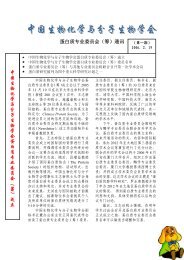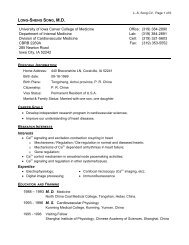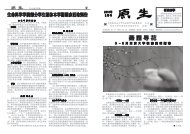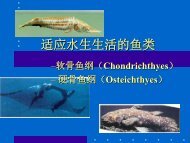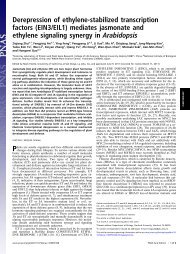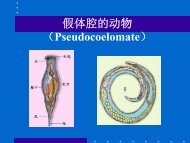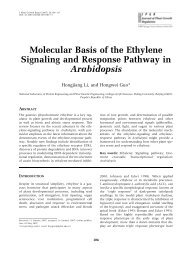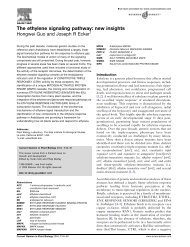Downloaded
Downloaded
Downloaded
You also want an ePaper? Increase the reach of your titles
YUMPU automatically turns print PDFs into web optimized ePapers that Google loves.
Published online 10 November 2008 Nucleic Acids Research, 2009, Vol. 37, Database issue D975–D982<br />
doi:10.1093/nar/gkn873<br />
Arabidopsis Hormone Database: a comprehensive<br />
genetic and phenotypic information database for<br />
plant hormone research in Arabidopsis<br />
Zhi-yu Peng 1 , Xin Zhou 2 , Linchuan Li 1 , Xiangchun Yu 1 , Hongjiang Li 1 ,<br />
Zhiqiang Jiang 1 , Guangyu Cao 1 , Mingyi Bai 3 , Xingchun Wang 4 , Caifu Jiang 5 ,<br />
Haibin Lu 6 , Xianhui Hou 1 , Lijia Qu 1 , Zhiyong Wang 3 , Jianru Zuo 4 , Xiangdong Fu 5 ,<br />
Zhen Su 2 , Songgang Li 1 and Hongwei Guo 1, *<br />
1 National Laboratory of Protein Engineering and Plant Genetic Engineering, College of Life Sciences,<br />
Peking University, Beijing 100871, 2 Division of Bioinformatics, State Key Laboratory of Plant Physiology and<br />
Biochemistry, College of Biological Sciences, China Agricultural University, 3 Key Laboratory of Plant<br />
Photosynthesis and Environmental Molecular Biology, Institute of Botany, Chinese Academy of Sciences,<br />
Beijing 100093, 4 State Key Laboratory of Plant Genomics and National Plant Gene Research Center (Beijing),<br />
Institute of Genetics and Developmental Biology, Chinese Academy of Sciences, Beijing 100101, 5 The State<br />
Key Laboratory of Plant Cell and Chromosome Engineering, Institute of Genetics and Developmental Biology,<br />
Chinese Academy of Sciences, Beijing 100101 and 6 National Institute of Biological Sciences, Beijing,<br />
Zhongguancun Life Science Park, Beijing 102206, China<br />
Received August 15, 2008; Revised September 28, 2008; Accepted October 18, 2008<br />
ABSTRACT<br />
Plant hormones are small organic molecules that<br />
influence almost every aspect of plant growth<br />
and development. Genetic and molecular studies<br />
have revealed a large number of genes that are<br />
involved in responses to numerous plant hormones,<br />
including auxin, gibberellin, cytokinin, abscisic<br />
acid, ethylene, jasmonic acid, salicylic acid, and<br />
brassinosteroid. Here, we develop an Arabidopsis<br />
hormone database, which aims to provide a systematic<br />
and comprehensive view of genes participating<br />
in plant hormonal regulation, as well as<br />
morphological phenotypes controlled by plant hormones.<br />
Based on data from mutant studies, transgenic<br />
analysis and gene ontology (GO) annotation,<br />
we have identified a total of 1026 genes in the<br />
Arabidopsis genome that participate in plant hormone<br />
functions. Meanwhile, a phenotype ontology<br />
is developed to precisely describe myriad hormoneregulated<br />
morphological processes with standardized<br />
vocabularies. A web interface (http://ahd.<br />
cbi.pku.edu.cn) would allow users to quickly get<br />
access to information about these hormone-related<br />
genes, including sequences, functional category,<br />
mutant information, phenotypic description, microarray<br />
data and linked publications. Several applications<br />
of this database in studying plant hormonal<br />
regulation and hormone cross-talk will be presented<br />
and discussed.<br />
INTRODUCTION<br />
Over the past century, extensive physiological and morphological<br />
studies have demonstrated that almost every<br />
aspect of plant growth and development is regulated by<br />
a small set of organic molecules referred to as plant hormones<br />
(1,2). In the recent decades, a great effort had been<br />
made by using the model plant Arabidopsis thaliana to<br />
uncover the genetic basis of plant hormonal regulation.<br />
Normally, a relatively simple and specific morphological<br />
response to a given type of hormone would be used as a<br />
screening phenotype to isolate genetic mutations that<br />
result in reduced or enhanced sensitivity to such hormone.<br />
Dozens of mutants that show altered response to certain<br />
type of hormone have been isolated and characterized for<br />
<strong>Downloaded</strong> from nar.oxfordjournals.org at Peking University Library on October 28, 2010<br />
*To whom correspondence should be addressed. Tel: 86 10 6276 7823; Fax: +86 (010) 6275 1526; Email: hongweig@pku.edu.cn<br />
Correspondence may also be addressed to Songgang Li. Fax: +86 (755) 2527 3620; Email: bgilsg@gmail.com<br />
The authors wish it to be known that, in their opinion, the first three authors should be regarded as joint First Authors.<br />
ß 2008 The Author(s)<br />
This is an Open Access article distributed under the terms of the Creative Commons Attribution Non-Commercial License (http://creativecommons.org/licenses/<br />
by-nc/2.0/uk/) which permits unrestricted non-commercial use, distribution, and reproduction in any medium, provided the original work is properly cited.
D976<br />
Nucleic Acids Research, 2009, Vol. 37, Database issue<br />
their involvement in plant hormone actions. As a result,<br />
a large number of genes that participate in various plant<br />
hormone responses, including hormone biosynthesis,<br />
metabolism, transport, perception and signal transduction,<br />
have been identified and characterized by means of<br />
forward genetic and reverse genetic approaches (3).<br />
However, there is so far not a collective database that<br />
could provide a systematic and comprehensive description<br />
on morphological phenotypes regulated by plant hormones,<br />
as well as regulatory genes participating in numerous<br />
plant hormone responses.<br />
It has been found that many biological processes are<br />
coordinately regulated by multiple hormones. Recent<br />
physiological and genetic studies together with the largescale<br />
analyses of microarray data indicated that there exist<br />
a wide range of cross-talks among different classes of plant<br />
hormones (4). The combination of these signals controls<br />
plant growth, development and response to myriad biotic<br />
and abiotic stresses in a complex manner (4,5). For example,<br />
ethylene and auxin can regulate a number of common<br />
processes including primary root elongation, root hair formation,<br />
hook formation, leaf epinasty and abscission (6).<br />
However, the molecular basis of many cross-talks among<br />
different hormones and signals remain poorly understood.<br />
It is thus necessary to summarize on how many types of<br />
plant hormones and in particularly what genes are<br />
involved in each kind of hormone-regulated phenotypes.<br />
This collection would certainly be of great help to plant<br />
researchers that are interested in deciphering the molecular<br />
code underlying those cross-talks among myriad plant<br />
hormone actions.<br />
Here, we report a database that collects 1026<br />
Arabidopsis genes related to the actions of eight plant<br />
hormones, including auxin (IAA), gibberellin (GA), cytokinin<br />
(CK), abscisic acid (ABA), ethylene (ET), jasmonic<br />
acid (JA), salicylic acid (SA) and brassinosteroid (BR).<br />
The database offers comprehensive information about<br />
plant hormone-related genes and plant hormone-regulated<br />
morphological processes. Meanwhile, a phenotype ontology<br />
is developed to systematically and precisely describe<br />
myriad hormone-regulated morphological processes using<br />
standardized vocabularies. Users can quickly get access to<br />
information about most, if not all, hormone-related genes<br />
reported in literatures from the web interface of the<br />
Arabidopsis hormone database (AHD) (http://ahd.cbi.pku.edu.cn).<br />
This user-friendly website allows searching for<br />
hormone-related genes and mutants by names, sequences,<br />
free texts, response hormones and mutant phenotypes.<br />
DATABASE CONTENT<br />
Collection of plant hormone-related genes<br />
We have identified Arabidopsis genes related to plant<br />
hormone functions (hormone-related genes) by following<br />
ways. First, by extensively reviewing literature of more<br />
than 330 papers published before August 2008, we collected<br />
302 genes that have been shown to participate in<br />
various aspects of hormone functions by genetic evidence<br />
(mutant analysis or transgenic over-expression studies).<br />
Among them, 282 genes were supported by mutant<br />
Table 1. Hormone-related genes in the AHD<br />
Hormone<br />
Genetic study<br />
Mutant<br />
No. of genes (supporting evidence)<br />
Transgenic<br />
Gene Ontology<br />
annotation<br />
Auxin 59 2 323 335<br />
Gibberellin 25 10 146 149<br />
Cytokinin 18 8 72 80<br />
Abscisic acid 78 1 252 289<br />
Ethylene 31 5 156 166<br />
Jasmonic acid 33 7 152 171<br />
Salicylic acid 22 2 116 135<br />
Brassinosteroid 35 2 43 58<br />
ALL hormone 282 36 923 1026<br />
analysis, 36 genes were derived from transgenic studies<br />
(Table 1), and 16 genes were supported by both mutant<br />
analysis and transgenic studies. We classified these genes<br />
into distinct functional categories, including hormone biosynthesis,<br />
hormone transport, hormone metabolism, hormone<br />
perception, hormone signal transduction and other<br />
aspects of hormone responses (Table 2). Second, we developed<br />
a Perl script to extract genes mapped to 72 gene<br />
ontology (GO) terms that are related to hormone actions<br />
(GO terms are listed in Table S1) from TAIR Arabidopsis<br />
gene ontology annotation. We collected totally 923 genes<br />
that are implicated in plant hormonal regulation in this<br />
manner (Table 1), of which, 199 genes were supported by<br />
genetic evidence. Combining the two sources of data<br />
together, we identified a total of 1026 Arabidopsis genes<br />
related to plant hormone actions (Table 1). This number<br />
might change after the database is constantly updated in<br />
the future.<br />
Description of plant hormone-regulated phenotypes<br />
For 302 plant hormone-related genes that have mutant or<br />
transgenic plant information, we describe phenotypes<br />
of these mutants and transgenic plants by comprehensive<br />
literature review.<br />
Integration of expression data of hormone-regulated genes<br />
High-throughput gene expression profiling allows a global<br />
analysis of transcriptional regulation in hormone<br />
responses. Gene expression arrays have been used to<br />
examine the RNA levels of Arabidopsis genes in response<br />
to exogenous treatments of a given hormone, or in various<br />
hormone-response mutants in Arabidopsis. A large collection<br />
of hormone-regulated genes have been identified<br />
in a series of published studies and are available to<br />
public domain (all references listed in the website). In<br />
the AHD, we integrated the expression data of the<br />
hormone-regulated genes derived from the supplementary<br />
data of numerous published papers. All expression levels<br />
of hormone-regulated genes are converted to and presented<br />
in log2 ratio to facilitate the comparison. The<br />
description of Materials and Methods for the experiments,<br />
the calculation of ratio, type of microarray (most of them<br />
are AFFYMETRIX chips), URLs of the original data and<br />
All<br />
<strong>Downloaded</strong> from nar.oxfordjournals.org at Peking University Library on October 28, 2010
Nucleic Acids Research, 2009, Vol. 37, Database issue<br />
D977<br />
Table 2. Functional categories of hormone-related genes<br />
Hormone Functional categories No. of<br />
all genes a<br />
Auxin Hormone biosynthesis 9<br />
Auxin Hormone metabolism 3<br />
Auxin Hormone receptor 4<br />
Auxin Hormone signal transduction 33<br />
Auxin Hormone transport 12<br />
Gibberellin Hormone biosynthesis 15<br />
Gibberellin Hormone metabolism 2<br />
Gibberellin Hormone receptor 3<br />
Gibberellin Hormone signal transduction 9<br />
Cytokinin Hormone biosynthesis 1<br />
Cytokinin Hormone metabolism 4<br />
Cytokinin Hormone receptor 4<br />
Cytokinin Hormone signal transduction 15<br />
Cytokinin Hormone transport 2<br />
Abscisic acid Hormone biosynthesis 9<br />
Abscisic acid Hormone metabolism 2<br />
Abscisic acid Hormone receptor 3<br />
Abscisic acid Hormone signal transduction 65<br />
Abscisic acid Plant development 2<br />
Ethylene Hormone biosynthesis 6<br />
Ethylene Hormone receptor 5<br />
Ethylene Hormone response 2<br />
Ethylene Hormone signal transduction 19<br />
Jasmonic acid Hormone biosynthesis 12<br />
Jasmonic acid Hormone receptor 1<br />
Jasmonic acid Hormone signal transduction 24<br />
Salicylic acid Hormone biosynthesis 1<br />
Salicylic acid Hormone metabolism 3<br />
Salicylic acid Hormone signal transduction 18<br />
Salicylic acid Hormone transport 1<br />
Brassinosteroid Hormone biosynthesis 12<br />
Brassinosteroid Hormone metabolism 2<br />
Brassinosteroid Hormone receptor 3<br />
Brassinosteroid Hormone signal transduction 18<br />
a Genes supported by genetic evidence.<br />
the links to the corresponding papers are enclosed in the<br />
general information for each microarray experiment.<br />
WEB INTERFACE<br />
The AHD provides user-friendly interface to display information.<br />
The information of hormone-related genes contains<br />
four sections (Figure 1). The first section indicates<br />
the type of hormone(s) related to the gene. Additional<br />
information in this section includes supporting evidence,<br />
functional categories, gene description and PubMed ID of<br />
the associated references (Figure 1A). The second section<br />
describes the basic gene information retrieved from other<br />
databases, including locus name, gene description, gene<br />
alias, gene model, gene sequences, gene ontology annotation<br />
from TAIR version 7 database (7), metabolic<br />
pathway annotation from KEGG database (8) and<br />
protein–protein interaction (PPI) data (Figure 1B). The<br />
third section lists the reported mutants (including transgenic<br />
plants) associated with the given gene (Figure 1C).<br />
Click on the links to the listed mutants will allow access to<br />
their respective phenotypes. The detailed information<br />
about the linked mutants is described below. The fourth<br />
section displays a graphic view of gene expression data<br />
if this gene is differentially regulated by one or multiple<br />
types of hormones based on the previously published<br />
microarray studies (Figure 1D).<br />
As to the mutant information, each mutant contains<br />
three sections: general information, gene(s) associated<br />
with the mutant and description of mutant phenotypes<br />
(Figure 2). General information includes the mutant’s ecotype,<br />
mutagenesis type and genetic feature (Figure 2A).<br />
The genotype information lists the mutated genes and<br />
mutated site for the given mutant (Figure 2B). Click on<br />
the links to the genes will allow access to detailed gene<br />
information (Figure 1). We have developed a standardized<br />
classification system to describe phenotypic traits of<br />
mutants identified in plant hormone research (Figure 2C).<br />
Phenotypic traits are classified into seven classes:<br />
root, cotyledon/leaf, hypocotyl/stem, flower, silique/seed,<br />
embryo and stress. These seven classes are further categorized<br />
into 63 subclasses (Figure 3). For instance, class<br />
‘root’ can be further divided into six subclasses: primary<br />
root, lateral root, root hairs, agravitropic root, swollen<br />
primary roots or lateral roots and other. Most root-related<br />
phenotypic traits reported in literatures can be included<br />
into the first five subclasses. Occasionally, if the root phenotypic<br />
traits are difficult to be classified into any of the<br />
above five subclasses, we categorize them into a subclasses<br />
designated as ‘other’ (Figure 3). All phenotypic traits of<br />
mutants are described by this standardized classification<br />
system.<br />
We have developed powerful search system to help users<br />
retrieve information. For gene information, users can<br />
search genes by gene name, gene description or responding<br />
hormones. We also provide NCBI BLAST to help users to<br />
search genes by sequences. For mutant information, users<br />
can search mutants by mutant name and hormones.<br />
Phenotype search allow users to acquire all mutants that<br />
have selected phenotypic traits, as well as genes associated<br />
with these mutants. For microarray data, users can search<br />
microarray experiments and retrieve expression data by<br />
type of hormone treatments and plant organ types. A<br />
detailed tutor on how to use the search system is provided<br />
on the website (http://ahd.cbi.pku.edu.cn/help).<br />
THE APPLICATION OF AHD<br />
Application of phenotype ontology<br />
Hormone-regulated phenotypes and their associated<br />
genes. Although different types of hormones might regulate<br />
distinctive aspects of plant growth and developmental<br />
processes, a common phenotypic trait could be controlled<br />
by multiple hormones (4). To systematically examine the<br />
effect of different hormones on any given phenotypic<br />
traits, we determine the number of genes and the types<br />
of hormones that regulate each subclass of phenotype.<br />
Among 60 phenotype subclasses we examined, 51 are<br />
regulated by multiple hormones (Table 3). Phenotypic<br />
traits that are related to trichome branching, stomata density,<br />
nonphototropic hypocotyls, gynoecium protrusion,<br />
no embryonic root, embryogenesis stage, cold, drought<br />
and osmosis are regulated by a single type of hormone<br />
according to literatures (Table 3). Therefore, our analysis<br />
support the notion that, although generally considered to<br />
<strong>Downloaded</strong> from nar.oxfordjournals.org at Peking University Library on October 28, 2010
D978<br />
Nucleic Acids Research, 2009, Vol. 37, Database issue<br />
A<br />
B<br />
C<br />
D<br />
Figure 1. Screenshot of gene information. The information of a hormone-related gene contains four sections, including (A) response hormone(s),<br />
(B) basic gene information retrieved from TAIR and KEGG, (C) associated mutants and (D) expression data from microarray experiments.<br />
play distinctive roles in regulating various aspects of plant<br />
life cycle, different types of hormones also act together to<br />
modulate the same biological processes in a complex<br />
manner.<br />
In order to determine how different hormones coordinate<br />
the regulation of a common phenotypic trait, we<br />
further analyzed a phenotypic trait that was reported to<br />
be regulated by multiple hormones: primary root elongation.<br />
Based on our database search, we have identified 120<br />
mutants that show a longer primary root length than wild<br />
type in a normal or hormone-treated condition. These<br />
mutants correspond to a total of 63 genes that regulate<br />
this phenotype. Among them, 12 genes are related to CK<br />
responses, 24 are ET-related genes, 2 are ABA-related, 18<br />
are auxin-related, 11 are JA-related, and 1 is for GA and 1<br />
for BR. To investigate the molecular mechanism of how<br />
these genes function coordinately to regulate primary<br />
root elongation, we tested whether their encoding<br />
products show PPI. Of 63 proteins, 23 can be mapped<br />
into protein-protein interaction networks via the web<br />
server of the Arabidopsis interactions viewer (http://bar.-<br />
utoronto.ca/interactions/cgi-bin/arabidopsis_interactions<br />
_viewer.cgi). And 17 out of 23 hormone-related proteins<br />
are interconnected by direct interactions or through intermediate<br />
protein(s) in a single network (Figure 4,<br />
Table S2). Interestingly, only three genes are involved in<br />
response to multiple hormones, whereas 14 others are<br />
related to a single type of hormone. This result implies<br />
that different hormones regulate a common process<br />
likely by sharing an interconnected regulatory network,<br />
but not by the same genes.<br />
Co-regulation of different phenotypes. Based on our database<br />
analysis, we found that the majority of phenotypic<br />
traits are regulated by a group of genes involved in multiple<br />
hormone responses (Table 3). We then surveyed<br />
<strong>Downloaded</strong> from nar.oxfordjournals.org at Peking University Library on October 28, 2010
Nucleic Acids Research, 2009, Vol. 37, Database issue<br />
D979<br />
A<br />
B<br />
C<br />
Figure 2. Screenshot of mutant information. The information of a<br />
mutant consists of three sections, including (A) general information,<br />
(B) genes corresponding to the mutant and (C) mutant phenotype<br />
information.<br />
Figure 3. Screenshot of phenotype ontology. The phenotype ontology<br />
consists of 7 major classes and 63 subclasses. Each phenotype can be<br />
classified into a provided subclass. Mutants with a given phenotype and<br />
genes associated with those mutants can be accessed through the hyperlinks<br />
in phenotype ontology.<br />
whether different phenotypes could be regulated by the<br />
same group of genes. We have identified 406 pairs of phenotypic<br />
traits, in which over 80% of associated genes in<br />
one trait are shared by the other trait (Table S3). For<br />
example, 12 genes have been shown to regulate swollen<br />
primary roots. Of the 12 genes, we found that all 12<br />
genes regulate small leaves, 11 genes regulate primary<br />
root length and shortened petiole, 10 genes regulate<br />
either reduced plant height, short hypocotyls, dark green<br />
leaf, rounded leaves, more root hairs or reduced lateral<br />
root, respectively (Figure 5). This result demonstrates<br />
that some phenotypic traits are highly related, suggesting<br />
that these correlated phenotypes might be physiologically<br />
or ecologically interconnected, or share the same origin in<br />
the evolution course.<br />
Hormone-related genes involved in multiple hormone<br />
functions<br />
One mechanism of hormone cross-talks is to share key<br />
regulatory components in multiple hormone response<br />
pathways. We found that almost any two types of hormones<br />
share more or less regulatory genes, except for BR<br />
and JA, BR and SA, and CK and JA (Table S4). We then<br />
explored how many hormone-related genes are involved in<br />
multiple hormone responses. Of the total 1026 hormonerelated<br />
genes supported by either genetic evidence or GO<br />
annotation evidence, we found that 17% of them participate<br />
in the function of more than one type of hormones<br />
(Figure S1, Table S5). At the extreme situation, we found<br />
21 genes that can respond to six hormones. Interestingly,<br />
all 21 genes encode transcription factors, 10 for MYB<br />
proteins and 11 for MYB-related proteins, suggesting<br />
that transcriptional regulation might be the key integration<br />
points in plant hormonal interactions.<br />
DISCUSSION<br />
The AHD integrates a large volume of literature data<br />
based on mutant studies, transgenic analysis, gene ontology<br />
annotation and microarray studies. A pronounced<br />
characteristic of this database is that we have developed<br />
a new set of standardized vocabularies to describe the<br />
phenotypic traits of a comprehensive collection of mutants<br />
identified in plant hormone research. It is easy to search<br />
for mutants and genes related to any given phenotype<br />
from this phenotype ontology. To date, several databases<br />
for Arabidopsis mutants are available (9–12), among<br />
which three databases have no mutant phenotype description<br />
(9,11,12) and one developed its own phenotypic classification<br />
system (10). In comparison with previously<br />
developed databases, the AHD phenotype ontology<br />
system has several distinctions and virtues: first, this<br />
system concentrates on Arabidopsis hormone-related<br />
mutants, and such a database had not been developed<br />
before. Second, this system integrates phenotypic traits<br />
derived from a large number of published studies supported<br />
by sound genetic evidence. Third, this system contains<br />
a more complete list of phenotype subclasses, and<br />
describes phenotypic traits in more details for hormonerelated<br />
mutants compared with other databases (10).<br />
To our knowledge, this database represents the first<br />
effort to systematically collect a wide range of published<br />
results, and contains the most comprehensive information<br />
on both hormone-related phenotypes and Arabidopsis<br />
genes regulating these phenotypes. Users can quickly get<br />
access to information about most, if not all, genes<br />
reported in literatures that regulate a given hormone function,<br />
including gene sequences, functional category,<br />
mutant information, phenotypic description, microarray<br />
data and linked publications. The phenotype ontology<br />
database provides a novel route to study plant hormone<br />
<strong>Downloaded</strong> from nar.oxfordjournals.org at Peking University Library on October 28, 2010
D980<br />
Nucleic Acids Research, 2009, Vol. 37, Database issue<br />
actions and interactions. It has been shown that many<br />
biological processes are regulated by multiple hormones<br />
that interplay in different ways, although the molecular<br />
basis of such interactions is not known. By use of this<br />
AHD database, we have conducted analyses on the interaction<br />
among multiple hormone pathways in regulating<br />
primary root elongation. Our analysis suggests that different<br />
phytohormones control this common trait probably by<br />
Table 3. The summary of hormone-regulated phenotypes<br />
Phenotypic traits<br />
No. of<br />
gene<br />
No. of<br />
hormone<br />
List of hormone<br />
Root 148 7 IAA, GA, CK, ABA, ET, JA, BR<br />
Primary root 122 7 IAA, GA, CK, ABA, ET, JA, BR<br />
Lateral root 67 6 IAA, CK, ABA, ET, JA, BR<br />
Root hairs 36 6 IAA, CK, ABA, ET, JA, BR<br />
Agravitropic root 27 5 IAA, ABA, ET, JA, BR<br />
Swollen primary roots or lateral roots 13 4 IAA, ET, JA, BR<br />
Cotyledon/Leaf 162 8 IAA, GA, CK, ABA, ET, JA, SA, BR<br />
Cotyledon number 11 5 IAA, GA, ABA, ET, JA<br />
Epinastic or hyponastic cotyledon 28 5 IAA, CK, ABA, ET, BR<br />
Vasculature pattern 26 5 IAA, ABA, ET, JA, BR<br />
Leaf size 83 8 IAA, GA, CK, ABA, ET, JA, SA, BR<br />
Rumpled or serrated leaves 29 5 IAA, ABA, ET, JA, BR<br />
Hyponastic or epinastic leaves 41 6 IAA, GA, ABA, ET, JA, BR<br />
Rounded or narrow leaves 46 5 IAA, ABA, ET, JA, BR<br />
Trichome branching 1 1 GA<br />
Stomata aperture 24 3 ABA, ET, BR<br />
Stomata density 1 1 ABA<br />
Leaf senescence 13 4 CK, ABA, ET, BR<br />
Leaf color 63 7 IAA, GA, CK, ABA, ET, JA, BR<br />
Petiole 52 7 IAA, GA, CK, ABA, ET, JA, BR<br />
Leaf growth in dark 7 4 IAA, ABA, ET, BR<br />
Hypocotyl/stem 145 7 IAA, GA, CK, ABA, ET, JA, BR<br />
Hypocotyl length 103 7 IAA, GA, CK, ABA, ET, JA, BR<br />
Shoot apical hook 38 5 IAA, GA, ABA, ET, BR<br />
Agravitropic hypocotyls 11 2 IAA, ABA<br />
Nonphototropic hypocotyls 6 1 IAA<br />
Plant height 95 7 IAA, GA, CK, ABA, ET, JA, BR<br />
Shoot apical dominance 50 7 IAA, GA, CK, ABA, ET, JA, BR<br />
Internode length 35 7 IAA, GA, CK, ABA, ET, JA, BR<br />
Flower 97 7 IAA, GA, CK, ABA, ET, JA, BR<br />
Flowering time under long day 30 7 IAA, GA, CK, ABA, ET, JA, BR<br />
Flowering time under short day 13 2 GA, ABA<br />
Flower size 16 5 IAA, ABA, ET, JA, BR<br />
Sepal 15 4 IAA, ET, JA, BR<br />
Petal 16 4 IAA, ET, JA, BR<br />
Stamen 26 6 IAA, GA, ABA, ET, JA, BR<br />
Carpel 13 5 IAA, GA, ET, JA, BR<br />
Gynoecium protrusion 2 1 IAA<br />
Anther development 20 5 IAA, ABA, ET, JA, BR<br />
Pollen development 24 6 IAA, GA, ABA, ET, JA, BR<br />
Fertility 71 7 IAA, GA, CK, ABA, ET, JA, BR<br />
Silique/Seed 128 7 IAA, GA, CK, ABA, ET, JA, BR<br />
Silique length 44 6 IAA, GA, ABA, ET, JA,BR<br />
Silique shape 10 4 IAA, ABA, ET, BR<br />
Germination rate 67 5 IAA, GA, ABA, ET, JA<br />
Loss of seed dormancy 21 4 GA, CK, ABA, BR<br />
Seed yield 45 6 IAA, GA, ABA, ET, JA, BR<br />
Seed size 5 4 IAA, CK, JA, BR<br />
Seed shape 3 2 ABA, JA<br />
Embryo 21 6 IAA, GA, ABA, ET, JA, BR<br />
Defective embryo development 15 4 IAA, ABA, JA, BR<br />
No embryonic root 9 1 IAA<br />
Embryo lethality 8 2 IAA, ABA<br />
Embryogenesis stage 2 1 IAA<br />
Stress response 88 6 IAA, GA, ABA, ET, JA<br />
Salt 23 3 GA, ABA, ET<br />
Cold 3 1 ABA<br />
Drought 12 1 ABA<br />
Pathogen 38 3 ET, JA<br />
Osmosis 13 1 ABA<br />
<strong>Downloaded</strong> from nar.oxfordjournals.org at Peking University Library on October 28, 2010
Nucleic Acids Research, 2009, Vol. 37, Database issue<br />
D981<br />
sharing a physically interconnected regulatory network,<br />
but not by sharing the same genes. We have discovered<br />
that certain groups of phenotypes are highly related due to<br />
the large overlap of their regulatory genes. We have also<br />
identified a class of multiple-hormone responsive MYB<br />
and MYB-like transcription factors that might mediate<br />
responses to as many as six hormones. These analyses<br />
Figure 4. PPI network of genes involved in regulating primary root<br />
length. The circles represent proteins and the lines indicate PPIs. The<br />
colored circles represent hormone-related proteins when mutated would<br />
cause a longer primary root phenotype. Different colors indicate different<br />
hormone classes. The uncolored circles represent proteins that show<br />
direct interaction with hormone-related proteins.<br />
demonstrate that our database is valuable in unraveling<br />
molecular mechanisms of plant hormone cross-talks in<br />
regulating various biological processes.<br />
Our database aims at providing a comprehensive and<br />
standardized resource for Arabidopsis hormone research.<br />
Each type of hormone has one or two experts to curate the<br />
database in a user-compatible manner, and to update<br />
the information in a timely manner. It is our belief that<br />
the database will benefit plant hormone researchers all<br />
over the world. Users can also help to improve the database<br />
via our interactive platform (http://ahd.cbi.pku.<br />
edu.cn/help.php). All useful information and comments<br />
will be properly considered and quickly integrated into<br />
the database by corresponding curators for each hormone.<br />
SUPPLEMENTARY DATA<br />
Supplementary Data are available at NAR Online.<br />
ACKNOWLEDGEMENTS<br />
We thank Qiyao Li for web decoration, Fengying An and<br />
Qiong Zhao for helpful discussion.<br />
FUNDING<br />
National Science Foundation, China (NSFC30625003<br />
and ED20060047 to H.G.). Funding for open access<br />
charge: 111 project.<br />
Conflict of interest statement. None declared.<br />
<strong>Downloaded</strong> from nar.oxfordjournals.org at Peking University Library on October 28, 2010<br />
Figure 5. Overlap of regulatory genes among different phenotypes. Each rectangle represents a phenotype. The number of genes regulating that<br />
phenotype is shown in parenthesis. The number on the arrow, which arrowhead points to the large geneset and arrowend points to the small geneset,<br />
represents the overlap of genes regulating two different phenotypes.
D982<br />
Nucleic Acids Research, 2009, Vol. 37, Database issue<br />
REFERENCES<br />
1. Davies,P.J. (1995) The Plant Hormones: Their Nature, Occurrence<br />
and Functions. Kluwer Academic Publishers, Dordrecht,<br />
The Netherlands.<br />
2. Bishopp,A., Mahonen,A.P. and Helariutta,Y. (2006) Signs of<br />
change: hormone receptors that regulate plant development.<br />
Development, 133, 1857–1869.<br />
3. Alonso,J.M. and Ecker,J.R. (2006) Moving forward in reverse:<br />
genetic technologies to enable genome-wide phenomic screens in<br />
Arabidopsis. Nat. Rev. Genet., 7, 524–536.<br />
4. Nemhauser,J.L., Hong,F. and Chory,J. (2006) Different plant hormones<br />
regulate similar processes through largely nonoverlapping<br />
transcriptional responses. Cell, 126, 467–475.<br />
5. Seki,M., Satou,M., Sakurai,T., Akiyama,K., Iida,K., Ishida,J.,<br />
Nakajima,M., Enju,A., Narusaka,M., Fujita,M. et al. (2004)<br />
RIKEN Arabidopsis full-length (RAFL) cDNA and its applications<br />
for expression profiling under abiotic stress conditions. J. Exp. Bot.,<br />
55, 213–223.<br />
6. Stepanova,A.N., Hoyt,J.M., Hamilton,A.A. and Alonso,J.M. (2005)<br />
A link between ethylene and auxin uncovered by the characterization<br />
of two root-specific ethylene-insensitive mutants in<br />
Arabidopsis. Plant Cell, 17, 2230–2242.<br />
7. Swarbreck,D., Wilks,C., Lamesch,P., Berardini,T.Z.,<br />
Garcia-Hernandez,M., Foerster,H., Li,D., Meyer,T., Muller,R.,<br />
Ploetz,L. et al. (2008) The Arabidopsis Information Resource<br />
(TAIR): gene structure and function annotation. Nucleic Acids Res.,<br />
36, D1009–D1014.<br />
8. Kanehisa,M., Goto,S., Hattori,M., Aoki-Kinoshita,K.F., Itoh,M.,<br />
Kawashima,S., Katayama,T., Araki,M. and Hirakawa,M. (2006)<br />
From genomics to chemical genomics: new developments in KEGG.<br />
Nucleic Acids Res., 34, D354–D357.<br />
9. Li,Y., Rosso,M.G., Viehoever,P. and Weisshaar,B. (2007)<br />
GABI-Kat SimpleSearch: an Arabidopsis thaliana T-DNA mutant<br />
database with detailed information for confirmed insertions. Nucleic<br />
Acids Res., 35, D874–D878.<br />
10. Kuromori,T., Wada,T., Kamiya,A., Yuguchi,M., Yokouchi,T.,<br />
Imura,Y., Takabe,H., Sakurai,T., Akiyama,K., Hirayama,T. et al.<br />
(2006) A trial of phenome analysis using 4000 Ds-insertional<br />
mutants in gene-coding regions of Arabidopsis. Plant J., 47,<br />
640–651.<br />
11. Pan,X., Liu,H., Clarke,J., Jones,J., Bevan,M. and Stein,L. (2003)<br />
ATIDB: Arabidopsis thaliana insertion database. Nucleic Acids<br />
Res., 31, 1245–1251.<br />
12. Ito,T., Motohashi,R., Kuromori,T., Noutoshi,Y., Seki,M.,<br />
Kamiya,A., Mizukado,S., Sakurai,T. and Shinozaki,K. (2005)<br />
A resource of 5,814 dissociation transposon-tagged<br />
and sequence-indexed lines of Arabidopsis transposed<br />
from start loci on chromosome 5. Plant Cell Physiol., 46,<br />
1149–1153.<br />
<strong>Downloaded</strong> from nar.oxfordjournals.org at Peking University Library on October 28, 2010



